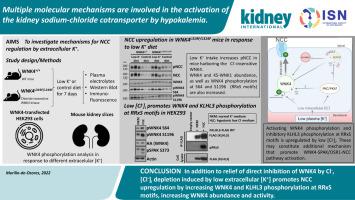Kidney International ( IF 14.8 ) Pub Date : 2022-07-21 , DOI: 10.1016/j.kint.2022.06.027 Adrián R Murillo-de-Ozores 1 , Héctor Carbajal-Contreras 2 , Germán R Magaña-Ávila 1 , Raquel Valdés 3 , Leoneli I Grajeda-Medina 4 , Norma Vázquez 5 , Teresa Zariñán 6 , Alejandro López-Saavedra 7 , Avika Sharma 8 , Dao-Hong Lin 9 , Wen-Hui Wang 9 , Eric Delpire 10 , David H Ellison 11 , Gerardo Gamba 12 , María Castañeda-Bueno 4

|
Low potassium intake activates the kidney sodium-chloride cotransporter (NCC) whose phosphorylation and activity depend on the With-No-Lysine kinase 4 (WNK4) that is inhibited by chloride binding to its kinase domain. Low extracellular potassium activates NCC by decreasing intracellular chloride thereby promoting chloride dissociation from WNK4 where residue L319 of WNK4 participates in chloride coordination. Since the WNK4-L319F mutant is constitutively active and chloride-insensitive in vitro, we generated mice harboring this mutation that displayed slightly increased phosphorylated NCC and mild hyperkalemia when on a 129/sv genetic background. On a low potassium diet, upregulation of phosphorylated NCC was observed, suggesting that in addition to chloride sensing by WNK4, other mechanisms participate which may include modulation of WNK4 activity and degradation by phosphorylation of the RRxS motif in regulatory domains present in WNK4 and KLHL3, respectively. Increased levels of WNK4 and kidney-specific WNK1 and phospho-WNK4-RRxS were observed in wild-type and WNK4L319F/L319F mice on a low potassium diet. Decreased extracellular potassium promoted WNK4-RRxS phosphorylation in vitro and ex vivo as well. These effects might be secondary to intracellular chloride depletion, as reduction of intracellular chloride in HEK293 cells increased phospho-WNK4-RRxS. Phospho-WNK4-RRxS levels were increased in mice lacking the Kir5.1 potassium channel, which presumably have decreased distal convoluted tubule intracellular chloride. Similarly, phospho-KLHL3 was modulated by changes in intracellular chloride in HEK293 cells. Thus, our data suggest that multiple chloride-regulated mechanisms are responsible for NCC upregulation by low extracellular potassium.
中文翻译:

低钾血症激活肾脏钠氯化物协同转运蛋白涉及多种分子机制
低钾摄入量会激活肾脏钠氯化物协同转运蛋白 (NCC),其磷酸化和活性取决于无赖氨酸激酶 4 (WNK4),而 WNK4 会被与其激酶结构域结合的氯化物所抑制。低细胞外钾通过减少细胞内氯来激活 NCC,从而促进氯从 WNK4 解离,其中 WNK4 的残基 L319 参与氯配位。由于 WNK4-L319F 突变体在体外具有组成型活性且对氯不敏感,因此我们生成了携带该突变的小鼠,在 129/sv 遗传背景下,这些小鼠表现出磷酸化 NCC 略有增加和轻度高钾血症。在低钾饮食中,观察到磷酸化 NCC 的上调,这表明除了 WNK4 的氯感应之外,其他机制也参与其中,其中可能包括调节 WNK4 活性以及通过 WNK4 和 KLHL3 中存在的调节域中的 RRxS 基序磷酸化来降解。分别。在低钾饮食的野生型和 WNK4 L319F/L319F小鼠中观察到 WNK4 和肾脏特异性 WNK1 和磷酸化 WNK4-RRxS 水平升高。细胞外钾的减少也会促进 WNK4-RRxS体外和离体磷酸化。这些影响可能继发于细胞内氯离子消耗,因为 HEK293 细胞中细胞内氯离子的减少增加了磷酸化 WNK4-RRxS。缺乏 Kir5.1 钾通道的小鼠中 Phospho-WNK4-RRxS 水平升高,这可能导致远端曲小管细胞内氯离子减少。类似地,HEK293 细胞中磷酸化 KLHL3 受到细胞内氯离子变化的调节。因此,我们的数据表明,多种氯调节机制是低细胞外钾导致 NCC 上调的原因。











































 京公网安备 11010802027423号
京公网安备 11010802027423号